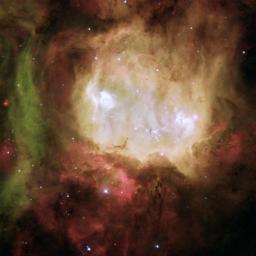Looking like a colorful holiday card, a new image from NASA's Hubble Space Telescope reveals a vibrant green and red nebula far from Earth.
The image of NGC 2080, taken by Hubble's Wide Field and Planetary Camera 2, designed and built by NASA's Jet Propulsion Laboratory, Pasadena, Calif., is available online at http://www.jpl.nasa.gov/images/wfpc . Images like this help astronomers investigate star formation in nebulas.
NGC 2080, nicknamed "The Ghost Head Nebula," is one of a chain of star-forming regions lying south of the 30 Doradus nebula in the Large Magellanic Cloud. 30 Doradus is the largest star-forming complex in the local group of galaxies. This "enhanced color" picture is composed of three narrow-band-filter images obtained by Hubble on March 28, 2000.
The red and blue light come from regions of hydrogen gas heated by nearby stars. The green light on the left comes from glowing oxygen. The energy to illuminate the green light is supplied by a powerful stellar wind, a stream of high-speed particles coming from a massive star just outside the image. The central white region is a combination of all three emissions and indicates a core of hot, massive stars in this star-formation region. Intense emission from these stars has carved a bowl-shaped cavity in surrounding gas.
In the white region, the two bright areas (the "eyes of the ghost") - named A1 (left) and A2 (right) -- are very hot, glowing "blobs" of hydrogen and oxygen. The bubble in A1 is produced by the hot, intense radiation and powerful stellar wind from one massive star. A2 contains more dust and several hidden, massive stars. The massive stars in A1 and A2 must have formed within the last 10,000 years, since their natal gas shrouds are not yet disrupted by the powerful radiation of the newborn stars.
The Space Telescope Science Institute is operated by the Association of Universities for Research in Astronomy, Inc., for NASA, under contract with the Goddard Space Flight Center, Greenbelt, Md. The Hubble Space Telescope is a project of international co-operation between the European Space Agency and NASA. The California Institute of Technology in Pasadena manages JPL for NASA.

 Planetary Data System
Planetary Data System












